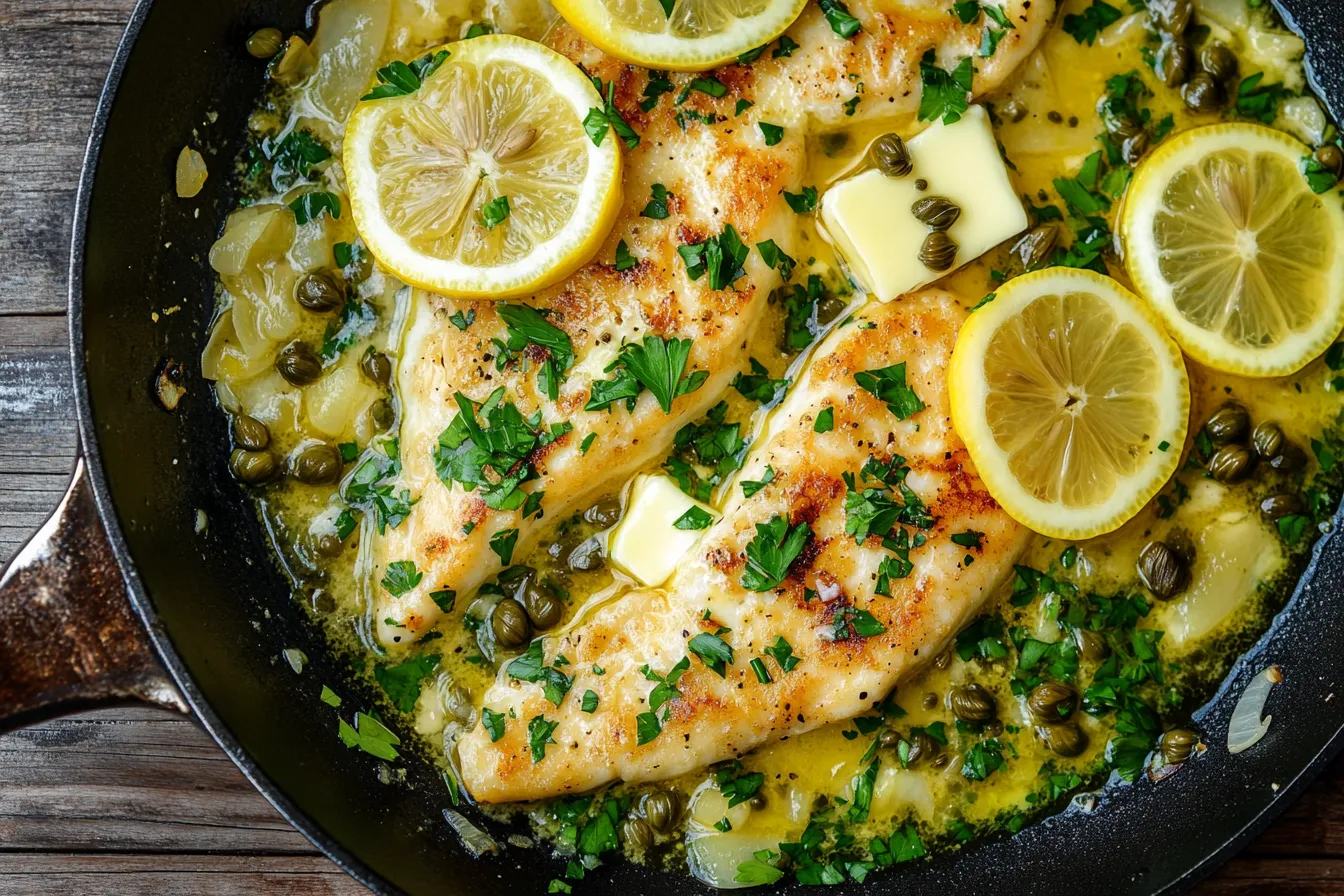Introduction
If you’ve ever been enchanted by the tangy, buttery explosion of flavor in a dish like chicken piccata, you already know the power of piccata sauce. This bold, lemon-forward sauce has made its way from traditional Italian kitchens to the dinner tables of home cooks across the globe. With just a handful of ingredients—butter, lemon juice, capers, and optionally wine or broth—this sauce delivers a savory zing that’s truly unforgettable.
But what makes this simple sauce so iconic? The beauty of piccata sauce lies in its balance of richness and brightness. The lemon cuts through the fat of the butter, while the capers bring that distinctive salty punch. It’s this harmony that makes it the ideal accompaniment to chicken, veal, fish, and even vegetarian dishes like tofu or pasta..Cooked 3 oz Chicken Breast
Whether you’re preparing a weeknight dinner or hosting a weekend get-together, homemade piccata sauce can elevate any dish into something restaurant-worthy. It’s fast, it’s flexible, and it’s impressively flavorful. Plus, it’s naturally low in carbs and packed with zesty Mediterranean flair.
In this long-form guide, we’ll explore every facet of piccata sauce—from its Italian-American roots to modern-day twists and pro kitchen techniques. You’ll learn how to make it, how to use it, and how to keep it fresh. Get ready to unlock the secrets of one of the most delicious and versatile sauces in the culinary world.
The Origins of Piccata Sauce
History of Piccata From Italy to America
The term “piccata” originates from the Italian word piccato, meaning “to be pounded flat.” In Italian cuisine, it’s not the name of a sauce but rather a method of preparing meat, particularly veal. In traditional Italian recipes, the meat is thinly sliced, lightly floured, sautéed in butter, and served in a lemony pan sauce often finished with capers and white wine.
While the original veal piccata still holds cultural significance in Italy, it’s in America where the dish—and the sauce gained mainstream fame. Italian immigrants brought the technique over in the early 20th century, and like many cultural recipes, it adapted to the ingredients and tastes available in the U.S. Thus, chicken piccata became a staple in Italian-American households and restaurants.
In these American kitchens, the sauce evolved from a simple lemon-butter base to a more complex, restaurant-style sauce often incorporating wine, garlic, parsley, and even cream. Today, it’s the flavorful piccata sauce itself that’s often the star, served with a variety of proteins or even drizzled over pasta.
Evolution into the American Kitchen
In Italian-American cooking, versatility is key. The sauce that began as a simple accompaniment to veal transformed into a beloved multi-purpose sauce. One of the reasons for this evolution is accessibility: veal is expensive and less commonly used in American kitchens. So, chicken became the natural substitute, and soon, home cooks began asking the question: “Can I just make the sauce and pair it with anything?”
The answer was yes and that’s when piccata sauce began to stand alone as a signature Italian-American flavor base. Over time, the recipe took on regional twists: some added heavy cream for richness, others used broth to tone down the acidity. Some even added a splash of Worcestershire or Dijon mustard for complexity.
The best part? Every version retains that signature brightness and umami that made the original dish a classic. Today, piccata sauce is one of the few Italian-American sauces known by name and used widely across multiple types of dishes even among those who have never heard of veal piccata.
Cultural Significance Today
What makes piccata sauce so special in today’s food culture is that it’s one of the rare sauces that feels both elegant and accessible. You can prepare it in under 15 minutes with basic pantry staples, yet it’s fancy enough to impress at dinner parties or holiday meals..Trader Joe’s Tomato & Burrata Ravioloni
It’s also gained momentum on food blogs, cooking channels, and TikTok recipe videos due to its:
- Short prep time
- Big flavor payoff
- Minimal ingredients
- Low-carb and keto-friendly nature
In a culinary world where fast food and over-complicated recipes compete for attention, piccata sauce stands as a shining example of how simplicity and tradition can yield unforgettable taste.
Core Ingredients of Piccata Sauce
Butter The Silky Foundation
Butter is more than just a fat in this sauce it’s the core of the texture and richness. Unsalted butter is preferred because it allows you to control the salt levels, especially when you add capers or broth.
In traditional recipes, butter is used in two phases:
- To sauté garlic or aromatics.
- To emulsify and finish the sauce for that luscious, velvety feel.
The trick is to whisk the cold butter in at the end, so it melts slowly and creates a thick, glossy sauce. If your butter gets too hot too quickly, the sauce may split. Keep it low and slow for best results.
Lemon Juice The Bright Soul of the Sauce
If butter is the soul, lemon juice is the heart of piccata sauce. It provides the acidity and brightness that cuts through the richness of the butter and complements the saltiness of the capers. Always use freshly squeezed lemon juice. Bottled lemon juice often has preservatives that mute the sharp citrusy notes.
Some recipes call for zest, which can add a slightly bitter undertone if not used carefully. A good tip is to zest the lemon before cutting it, and use just a pinch for aroma.
📌 Pro Tip: Want a smoother sauce with less acidity? Use Meyer lemons, which are naturally sweeter and less tangy than regular lemons.
Capers The Salty Punch
Capers are small, green flower buds preserved in brine or salt, and they pack a flavorful punch in every bite. In piccata sauce, they offer a savory contrast to the brightness of lemon and richness of butter.
Make sure to drain and rinse your capers before adding them to reduce the briny sharpness. Stir them in toward the end so they remain plump and don’t overcook.
Garlic Optional but Powerful
While not part of every traditional recipe, many American versions of piccata sauce use fresh garlic to add depth. Sautéing garlic in butter before adding the liquids creates a foundation of flavor that enhances the rest of the ingredients.
Use finely minced or crushed garlic for the best integration. Just be sure not to let it brown, or the entire sauce can take on a bitter taste.
Chicken Broth or White Wine The Liquid Backbone
You’ll need a liquid base to deglaze the pan and carry the sauce. You can choose between:
- White wine (like Sauvignon Blanc or Pinot Grigio) for depth and tang.
- Chicken broth for a milder, non-alcoholic alternative.
Both work beautifully. Many home cooks even combine them for a layered flavor.
If using wine, allow it to reduce slightly to cook off the alcohol and intensify the flavor.
Salt, Pepper & Parsley The Final Finishers
- Salt & pepper are essential, but go light on salt until after tasting. Capers and broth may already add enough.
- Fresh parsley is often sprinkled over the finished dish. It’s not just for looks it brings a refreshing, herby finish that balances the richness..Slow Cooker Chicken Tenders Recipe
Optional Ingredients to Elevate the Sauce
| Ingredient | Purpose |
|---|---|
| Shallots | Sweeter, milder alternative to garlic |
| Dijon mustard | Adds a tangy complexity |
| Red pepper flakes | Introduces gentle heat |
| Heavy cream | Makes a creamy version of piccata sauce |
This list is flexible, allowing home cooks to tailor the sauce to their own taste preferences while keeping the spirit of piccata intact.
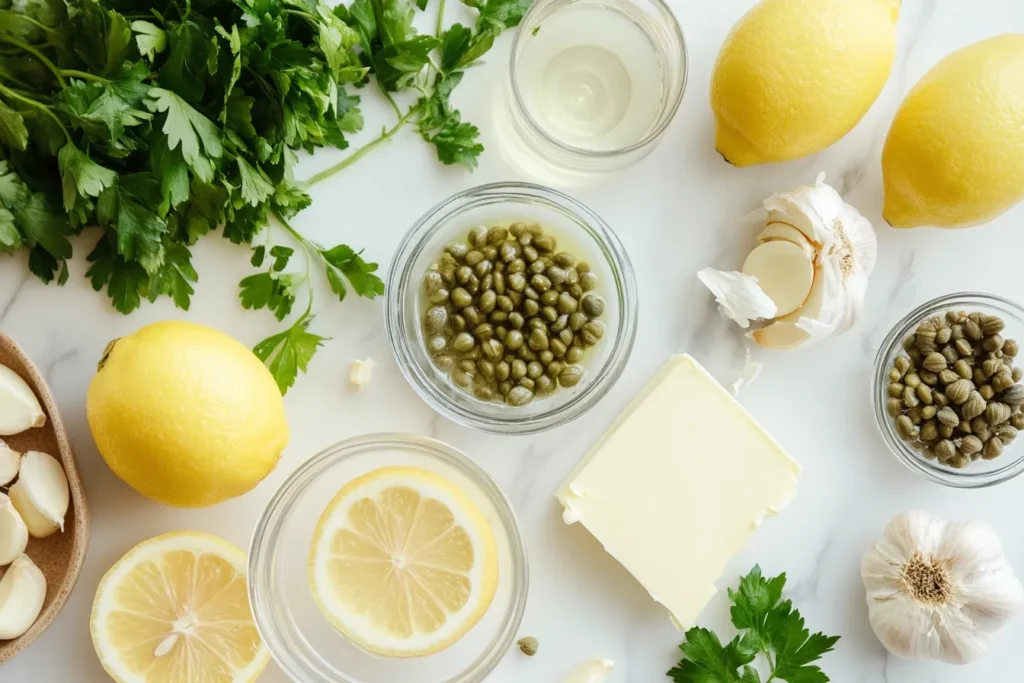
How to Make Traditional Piccata Sauce
Whether you’re prepping dinner for a crowd or just craving restaurant-quality flavor at home, making piccata sauce from scratch is quick and simple. This step-by-step recipe delivers bold flavor using basic ingredients—all in under 15 minutes.
Ingredients List (Serves 4)
| Ingredient | Quantity |
|---|---|
| Unsalted butter | 4 tablespoons (divided) |
| Garlic (optional) | 2 cloves, minced |
| White wine | 1/3 cup |
| Chicken broth | 1/2 cup |
| Fresh lemon juice | 1/4 cup |
| Capers (rinsed) | 2 tablespoons |
| Salt & pepper | To taste |
| Fresh parsley | Optional, for garnish |
📌 Optional twist: Add 1–2 tablespoons of heavy cream at the end for a creamy piccata variation.
Equipment You’ll Need
- Medium skillet (stainless or nonstick)
- Whisk
- Measuring cups and spoons
- Citrus squeezer or reamer
- Fine mesh strainer (optional, for capers)
Step-by-Step Cooking Instructions
Step 1: Melt Butter & Sauté Garlic
Place a skillet over medium heat. Melt 2 tablespoons of butter. If using garlic, add it now and sauté for about 30 seconds until fragrant. Don’t let it brown this sauce should be smooth, not bitter.
Step 2: Deglaze with Wine
Pour in the white wine to deglaze the pan, scraping up any flavorful bits stuck to the bottom. Let it simmer for 2–3 minutes to burn off the alcohol and concentrate the flavor.
If skipping wine, go straight to broth in the next step.
Step 3: Add Lemon Juice and Chicken Broth
Pour in the lemon juice and chicken broth, stirring to combine. Let the sauce simmer gently for another 3–4 minutes. This allows the flavors to mingle and the sauce to reduce slightly.
Step 4: Stir in Capers
Add the rinsed capers and let them heat through. The saltiness will begin to blend into the sauce.
Step 5: Finish with Butter
Turn off the heat and whisk in the remaining 2 tablespoons of cold butter, one tablespoon at a time. This creates the emulsion, giving your sauce a silky, cohesive texture.
Optional: Add a splash of cream here for a richer finish.
Step 6: Taste and Adjust
Taste the sauce. Add a pinch of salt or pepper if needed. Some broths and capers are salty enough on their own, so always taste before seasoning further.
Visual Indicators of Perfect Sauce
- Slightly thickened but still pourable
- Glossy and golden
- Balanced tangy-salty flavor
It should coat the back of a spoon without being overly thick or greasy.
Common Mistakes to Avoid
| Mistake | What Happens | How to Fix It |
|---|---|---|
| Adding butter too early | Sauce separates | Always finish with cold butter |
| Overcooking garlic | Sauce becomes bitter | Sauté garlic gently for 30 seconds |
| Using bottled lemon juice | Dull, flat taste | Always use fresh lemons |
| Not rinsing capers | Sauce too salty | Rinse under water before using |
| Skipping reduction | Sauce too thin or bland | Simmer wine & broth until reduced |
How Long Does It Take?
⏱ Total Prep & Cook Time: 10 to 12 minutes
No need to simmer for long or thicken with flour. This is a quick pan sauce, ideal for weeknights or when you want something elegant fast..Alice Springs Chicken Casserole
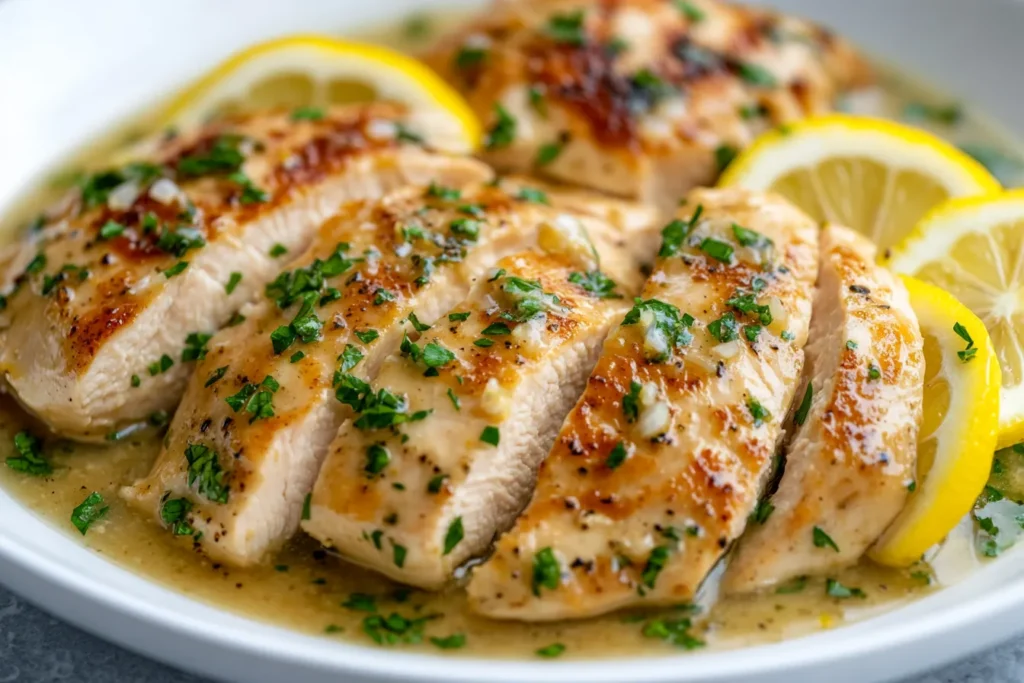
Best Ways to Use Piccata Sauce
Piccata sauce isn’t just limited to chicken. Thanks to its zesty, buttery profile, this sauce shines across a wide range of proteins, grains, and even plant-based dishes. Whether you’re a meat lover, pescatarian, or vegan, there’s a way to let piccata sauce steal the show in your kitchen.
Chicken Piccata The Iconic Pairing
Chicken piccata is the most common and beloved dish using this sauce. It’s easy to prepare:
- Pound chicken breasts thin.
- Dredge lightly in flour.
- Sauté in olive oil or butter until golden.
- Pour warm piccata sauce over the top.
The sauce soaks into the crispy chicken, delivering a punch of bright citrus, buttery richness, and salty caper tang in every bite.
📌 Serve it with:
- Angel hair pasta
- Roasted potatoes
- Steamed green beans
Veal Piccata Traditional Italian Style
Going back to its roots, veal piccata offers a more luxurious take on the dish. Thin veal cutlets, when lightly fried, become delicate and tender a perfect match for the bold sauce.
Though veal isn’t as widely used in American home cooking, it still reigns supreme in many Italian restaurants and formal dining menus.
Pro Tip: Ask your butcher to pre-slice veal scallopini to save time.
Fish Piccata – Light & Lemony Perfection
Piccata sauce also pairs beautifully with white fish. It balances the flaky, mild flavor of fish with its rich tanginess.
Best fish choices:
- Cod
- Sole
- Tilapia
- Halibut
- Trout
Method:
- Pan-sear the fillet in olive oil.
- Drizzle piccata sauce on top.
- Garnish with fresh dill or lemon zest for added freshness.
It’s a perfect light summer dinner when paired with asparagus, arugula salad, or quinoa.
Vegetarian Options – Tofu, Cauliflower, Mushrooms
Piccata sauce doesn’t have to be reserved for meat. It’s naturally vegetarian-friendly and can turn plant-based meals into decadent, satisfying plates.
Tofu Piccata
- Press and slice firm tofu
- Lightly dust with cornstarch
- Pan-sear until crispy
- Serve with piccata sauce and roasted veggies
Cauliflower Piccata
- Roast thick cauliflower steaks
- Drizzle sauce over the top
Mushroom Piccata
- Use thick Portobello caps or whole cremini mushrooms
- Sauté until browned
- Pour piccata sauce for a meaty, umami-rich vegetarian entrée
🌱 Vegan tip: Use plant-based butter and vegetable broth for a completely dairy-free version.
Pasta with Piccata Sauce
You don’t even need a protein! Pouring piccata sauce over pasta makes for a light, tangy, and satisfying main or side dish.
Great pasta choices:
- Angel hair (light and delicate)
- Linguine
- Orzo
Add-ins:
- Sautéed spinach
- Artichoke hearts
- Sun-dried tomatoes
- Grilled shrimp
This dish works great hot or cold, and it’s perfect for meal prep and lunchboxes.
Piccata-Inspired Grain Bowls
If you’re into healthy eating, try a Mediterranean-style grain bowl with piccata sauce. Start with a base of:
- Brown rice
- Quinoa
- Farro
Add:
- Grilled chicken or tofu
- Roasted broccoli or zucchini
- Cherry tomatoes
- Drizzle warm piccata sauce on top
This is a great meal-prep idea that tastes fresh even after a couple of days in the fridge.
Piccata Sauce as a Dip or Dressing
While less traditional, you can cool and thicken piccata sauce slightly to use it as:
- A dipping sauce for crusty bread
- A drizzle over grilled vegetables
- A warm vinaigrette-style dressing for lemony salads
To make it a dressing, blend in a little Dijon mustard and olive oil to emulsify it further.
Piccata sauce is truly limitless in the kitchen. Its bold, bright, and buttery flavor makes it an instant flavor upgrade for almost any dish.
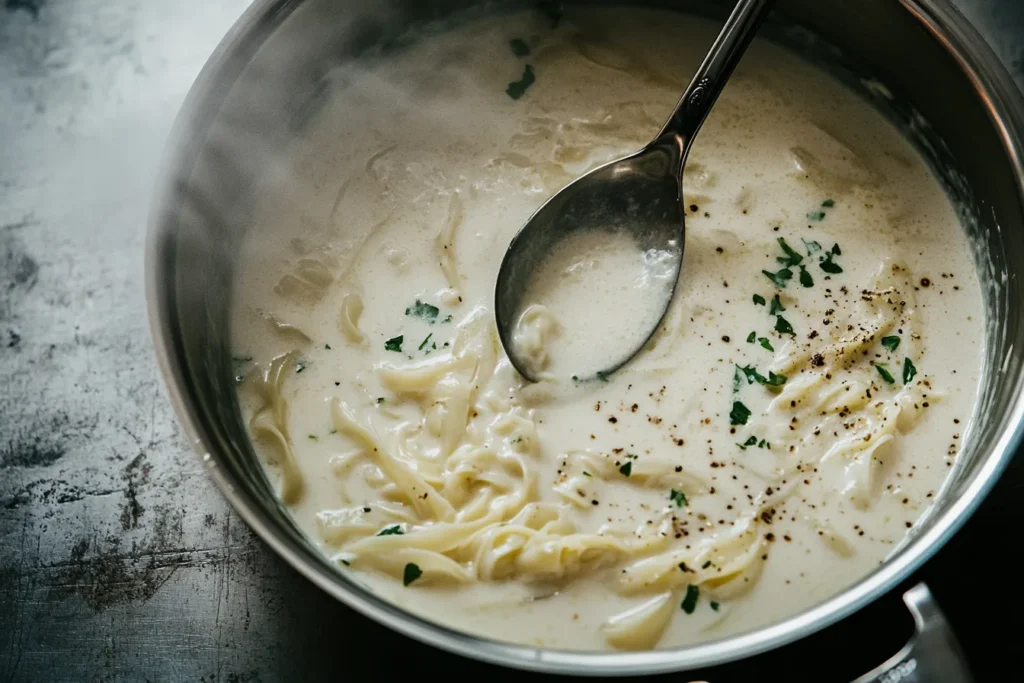
Piccata Sauce Variations
While the traditional recipe is unbeatable, piccata sauce is incredibly adaptable. You can tweak it for dietary preferences, elevate it with gourmet touches, or simplify it when you’re short on time. Let’s explore some of the most popular and delicious variations.
Creamy Piccata Sauce
Want a richer, restaurant-style flavor? Try adding heavy cream for a luscious creamy texture.
How to do it:
- After the sauce has reduced, stir in 1/4 cup of heavy cream before finishing with butter.
- Whisk continuously to blend and avoid curdling.
📌 Pairs perfectly with chicken or pasta dishes, especially when you want a sauce that clings beautifully to every bite.
Vegan & Dairy-Free Piccata Sauce
Eating plant-based? No problem! You can make a vegan-friendly piccata sauce with just a few swaps.
Substitutes:
- Use vegan butter or olive oil instead of dairy butter.
- Swap chicken broth for vegetable broth.
- Make it creamy with a splash of coconut cream or unsweetened oat milk.
This version works great with tofu, cauliflower, or chickpeas.
Gluten-Free Piccata
Most classic recipes are already gluten-free since the sauce doesn’t require flour to thicken. Just double-check that your broth and wine are gluten-free certified.
If you’re dredging meat in flour before cooking, use rice flour or almond flour as a coating alternative.
Low-Sodium Piccata
Since capers and broth are naturally salty, a few tweaks can help lower the sodium:
- Use low-sodium broth
- Rinse capers thoroughly or reduce the quantity
- Avoid adding extra salt until the very end and only if needed
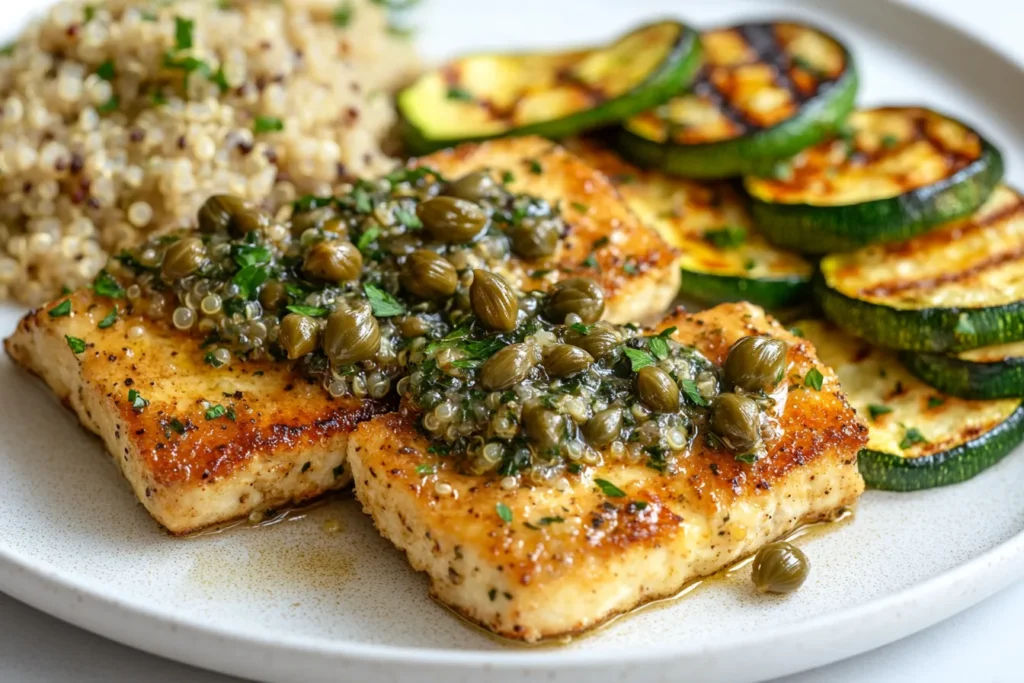
Frequently Asked Questions
What is piccata sauce made of?
Piccata sauce is a blend of butter, lemon juice, capers, and optionally white wine or chicken broth. Garlic and parsley are often added for extra flavor.
Can you make piccata sauce ahead of time?
Yes, absolutely! Store it in an airtight container in the fridge for up to 4 days. Reheat gently on the stove, whisking continuously to re-emulsify the butter.
What kind of wine is best for piccata sauce?
Dry white wines such as Pinot Grigio, Sauvignon Blanc, or Chardonnay work best. Avoid sweet wines as they can throw off the sauce’s flavor.
How do you make piccata sauce without wine?
Replace wine with chicken broth or vegetable stock. For a slightly acidic balance, add a touch more lemon juice or a splash of white vinegar.
Is piccata sauce gluten-free?
Yes, the sauce itself is naturally gluten-free. Just make sure your broth and any flour used for dredging meat are gluten-free too.
How long does piccata sauce last in the fridge?
It stays fresh for 3 to 4 days when stored in an airtight container. Reheat over low heat while stirring to maintain the creamy texture.
Conclusion
Piccata sauce is more than just a condiment it’s a bold, beautiful statement of flavor. With its tangy lemon base, briny capers, and buttery smooth finish, it’s no wonder that it has stood the test of time, transitioning from traditional Italian kitchens to global dinner tables.
From chicken and veal to fish, tofu, and pasta, piccata sauce enhances whatever it touches. And with so many ways to customize it creamy, vegan, gluten-free it truly is one of the most versatile sauces you can master.
So the next time you want to turn a simple dinner into something special, just remember: a squeeze of lemon, a swirl of butter, a handful of capers and voilà. Magic in a pan.
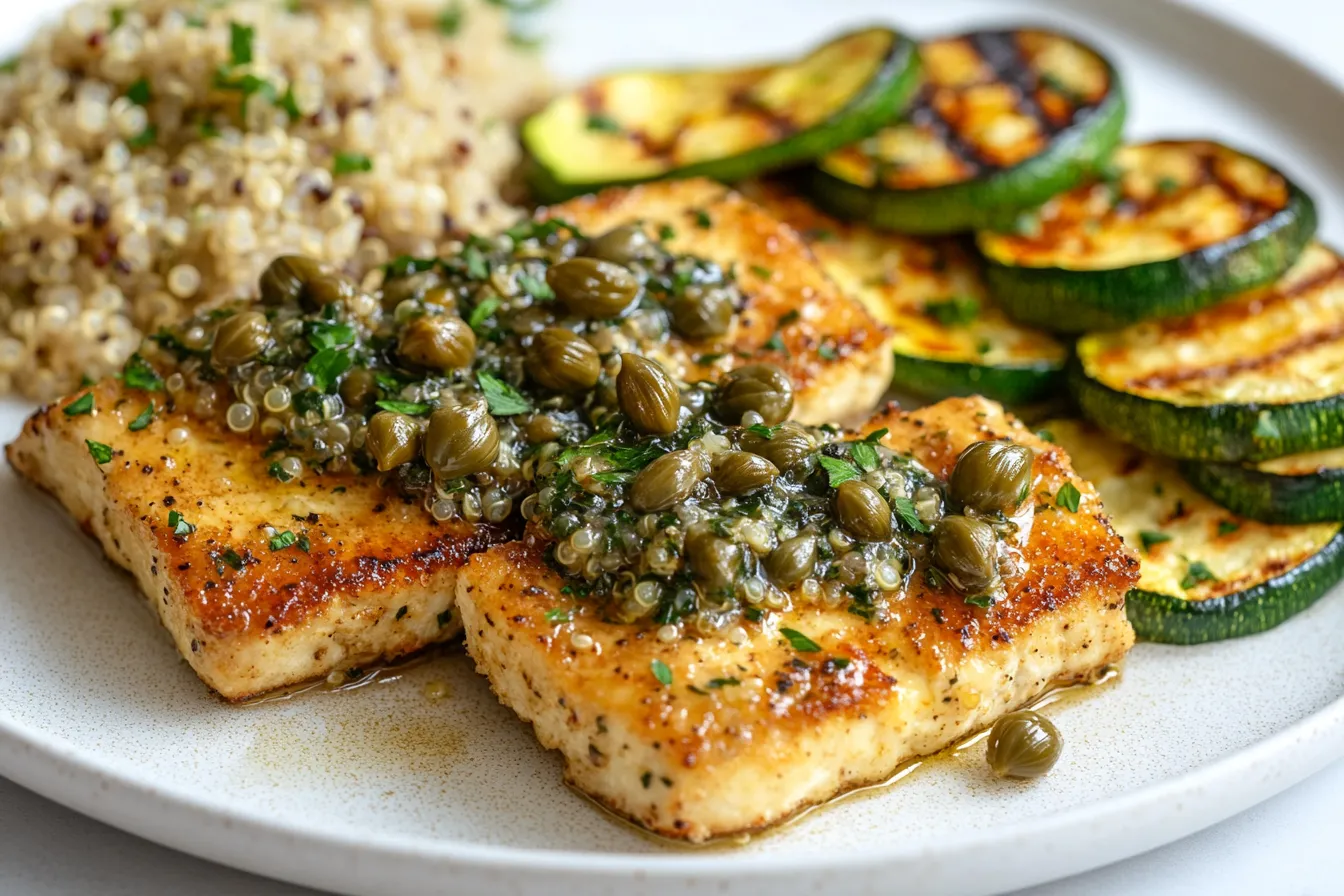
Name: Piccata Sauce
Ingredients
Equipment
Method
- Instructions:
- In a medium skillet over medium heat, melt 2 tablespoons of butter. Add minced garlic if using, and sauté for about 30 seconds, being careful not to brown it.
- Add white wine and simmer for 2–3 minutes to reduce slightly and burn off the alcohol.
- Stir in the lemon juice and chicken broth. Simmer gently for 3–4 minutes until slightly reduced.
- Add the rinsed capers and stir to combine.
- Turn off the heat and whisk in the remaining 2 tablespoons of cold butter, one at a time, to emulsify and thicken the sauce.
- Season with salt and pepper to taste. Garnish with fresh parsley if desired.
- Serve immediately over your preferred dish.
Notes
For a creamy variation, add 1/4 cup of heavy cream before whisking in the final butter. Substitute wine with more broth for an alcohol-free version. Use vegan butter and veggie broth for a plant-based alternative. Sauce can be stored in the fridge for up to 4 days and reheated gently on low.

